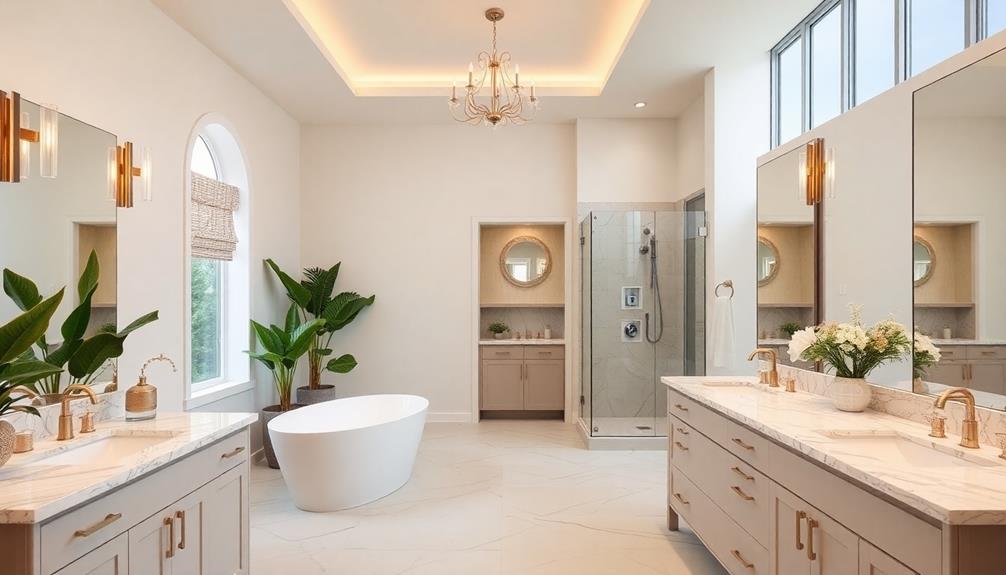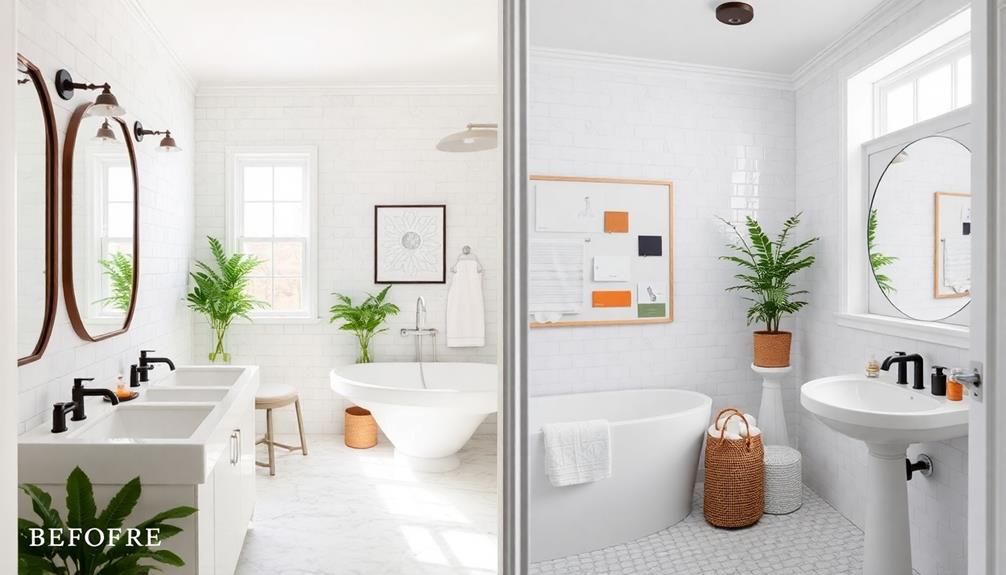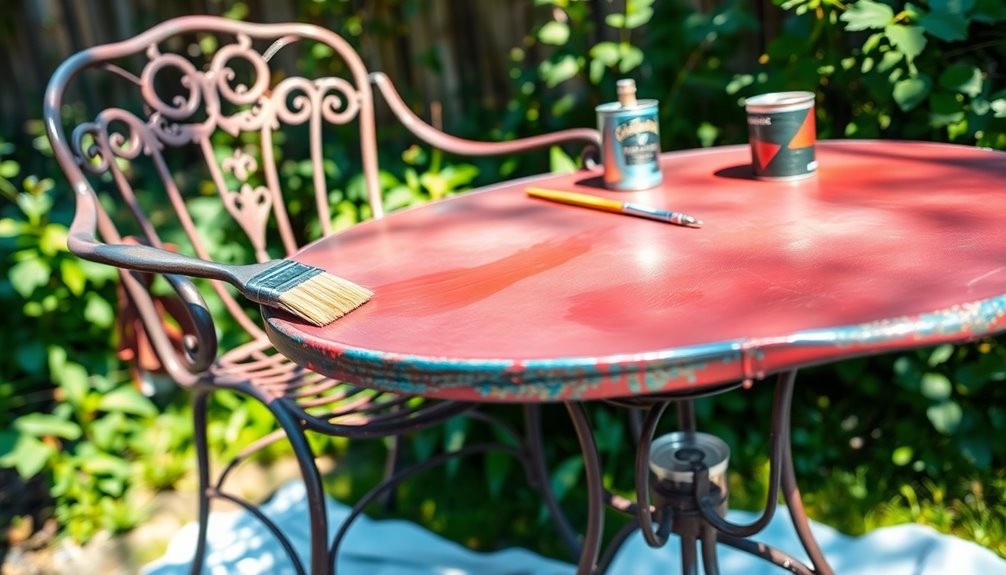To start planning your master bathroom remodel, begin by assessing your needs and evaluating the current layout. Take into consideration your lifestyle and storage requirements as you define a cohesive design concept that represents your personal style. It is important to establish a realistic budget that accounts for unexpected expenses and to choose high-quality materials wisely. Plan the layout to optimize space and ensure comfort, and remember to obtain any necessary permits. Depending on your skill level, you can choose to handle some tasks yourself or hire a contractor. By carefully organizing your project, you can achieve the bathroom of your dreams, with more details to explore in the process. When selecting fixtures and finishes, prioritize durability and ease of maintenance. Integrate energy-efficient lighting and water-saving fixtures to lower your environmental impact and utility costs. Additionally, consider investing in top-notch cabinetry and countertops for a classic and sophisticated appearance. These master bathroom remodel design tips will guide you in creating a practical, stunning space that elevates your daily routine.
Key Takeaways
- Assess your needs by evaluating the current layout, user preferences, and storage solutions to identify pain points in the existing bathroom.
- Define a cohesive design concept that reflects your style while incorporating functional elements like spacious showers and ample storage.
- Establish a budget that covers all costs, including materials, labor, and permits, while allowing for unexpected expenses of 10-20%.
- Choose durable, waterproof materials and high-quality fixtures to ensure long-term satisfaction and minimize maintenance issues.
- Decide whether to DIY or hire a contractor based on your skill level, project complexity, and available time while considering the associated costs.
Assessing Your Needs
When planning a bathroom remodel, start by evaluating your needs to create a space that truly works for you.
Begin by examining your current bathroom layout and pinpointing specific pain points. Is there enough storage? Are fixtures inconveniently placed? Identifying these issues will guide your bathroom design. Incorporating mood boards essential can help visualize how different elements will come together in your new space.
Next, consider how many people will use the space and their preferences. Do you want a soaking tub, a walk-in shower, or maybe a new vanity? These choices will enhance both functionality and comfort.
Don't forget about storage; think about adding built-in cabinets, shelving, or vanity drawers to keep your toiletries and linens organized.
While evaluating your needs, assess your existing plumbing and electrical systems. Determine what can be reused and what might need updates to guarantee your remodel meets your long-term usability needs.
Defining Design Concepts
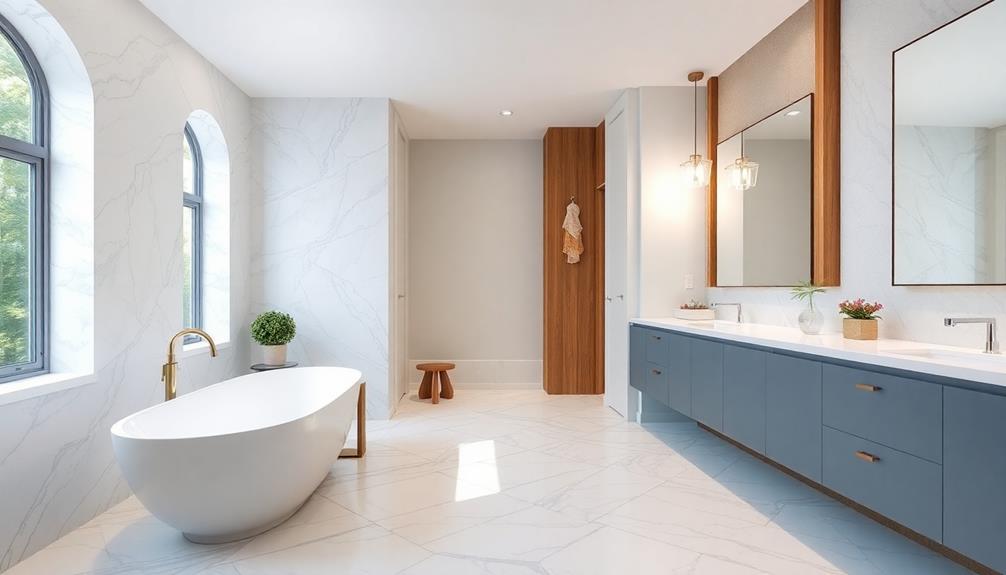
As you immerse yourself in defining design concepts for your bathroom remodel, focus on creating a cohesive vision that reflects your style and enhances functionality. Consider integrating luxurious elements typical of master baths, like freestanding tubs and spacious walk-in showers, which cater to relaxation and comfort. This adds an inviting atmosphere to your space.
Incorporating natural materials like wood and stone can further enhance the rustic charm and tranquility of your bathroom. Explore spa-inspired designs that create a tranquil environment. Using natural materials and soothing color palettes can help foster a sense of peace, making your bathroom a perfect retreat.
Don't forget that adequate storage is essential in high-traffic master bathrooms; built-in cabinets and shelving can keep your space organized and clutter-free.
Current design trends emphasize a minimalist aesthetic, which combines simplicity with high-quality finishes. This approach not only promotes style but also practical solutions for your bathroom remodeling project.
Establishing a Budget
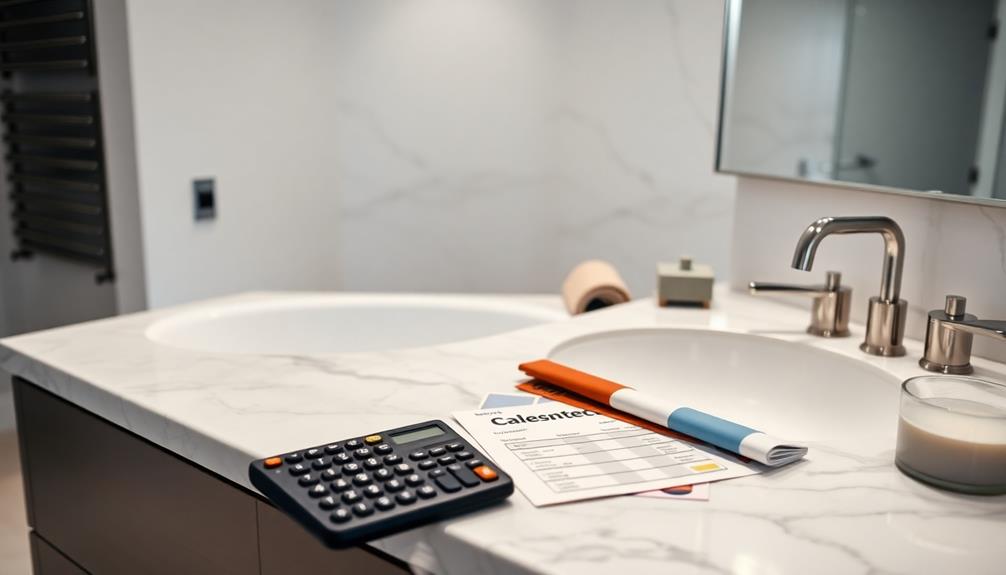
When you're establishing a budget for your bathroom remodel, it's vital to break down costs clearly.
Consider tracking your income and expenses to guarantee you stay within your means. Think about where you want to splurge on high-end fixtures and where you can save with budget-friendly options.
Creating a personal budget is essential for managing your finances effectively. By planning for unexpected expenses and understanding your total financial commitment, you'll set yourself up for a successful renovation.
Cost Breakdown Essentials
Creating a budget for your bathroom remodel is essential to guarantee you don't overspend or encounter financial surprises. Start by identifying the cost breakdown essentials for your project. A typical master bathroom renovation can range from $15,000 to over $30,000, depending on what you choose.
Consider the benefits of diversifying your financial investments, similar to how you'd with a retirement portfolio, as you plan your remodel budget; investing wisely can provide long-term returns, much like potential for higher returns with gold. Break down your budget into categories like plumbing fixtures, materials, labor, and permits to make sure you've covered all bases.
Allocate about 10-20% of your total budget for unexpected expenses that may pop up during the renovation. This cushion can save you from stress later on. Keep in mind that high-end materials and custom features can greatly increase costs, so decide where you want to splurge and where it's okay to save.
Research local market rates for contractors and materials to get a sense of realistic pricing in your area. This step is fundamental for establishing a budget that truly reflects your needs and resources.
Splurge vs. Save Strategies
Determining where to splurge and where to save in your bathroom remodel can make a significant difference in your overall budget. Aim to allocate about 20% of your total budget for splurging on high-impact items like fixtures, finishes, and a stylish bathroom vanity. These elements enhance aesthetic appeal and can elevate your space dramatically.
Additionally, just as many homeowners find that investing in a home security system can greatly increase their sense of safety, investing in key bathroom components can provide long-lasting satisfaction and comfort increased safety and peace of mind.
On the other hand, consider saving on less visible aspects, such as plumbing work or electrical upgrades. While you should invest in durable materials, like quartz countertops or high-quality tiles, don't hesitate to seek budget-friendly options for cabinetry or accessories.
You can also explore cost-saving strategies, like purchasing floor models or gently used fixtures, which can cut expenses by 30-50% without sacrificing quality.
Additionally, prioritize investing in waterproofing and ventilation systems, as this can prevent future repair costs.
Choosing Materials Wisely
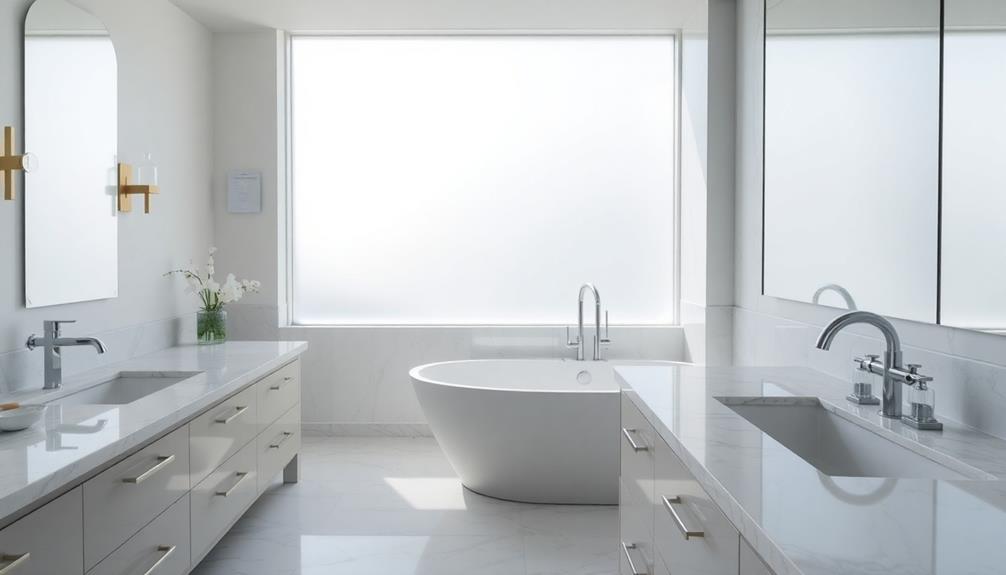
Selecting the right materials for your bathroom remodel can make all the difference in both functionality and aesthetics. Start by prioritizing waterproof options for your flooring materials, such as ceramic tile, porcelain tile, or luxury vinyl.
These choices will help prevent moisture damage, ensuring your bathroom remains beautiful and functional for years to come. Additionally, consider incorporating air purifiers to maintain a healthy indoor environment, as they can help reduce allergens and improve air quality in your newly remodeled space air purifier maintenance tips.
For countertops, consider durable materials like quartz or natural stone. They not only provide a premium look but also resist staining and scratching, which is vital in a high-use area like the bathroom.
When it comes to the walls, opt for mildew-resistant paint with a satin or semi-gloss finish. This enhances moisture protection and guarantees longevity in humid environments.
Don't forget your fixtures! Choose high-quality faucets and a shower head that focus on water efficiency. This will reduce your long-term water costs and lessen your environmental impact.
Planning the Layout

When planning the layout of your bathroom, it's crucial to assess the existing plumbing and electrical setups first. This will help you determine the feasibility of your desired changes in the new bathroom.
Once you've evaluated these systems, consider features that enhance both functionality and luxury, like a freestanding tub or a spacious walk-in shower. Additionally, incorporating smart storage solutions can maximize space efficiency and keep the area clutter-free, guaranteeing a serene atmosphere best vacuums for dust removal.
Next, evaluate the dimensions of your space. Aim for a minimum of 30 inches between fixtures to promote comfortable movement. This won't only make your master bath more functional but also more enjoyable to use.
Don't forget to prioritize natural light and ventilation; think about window placements and exhaust fan locations to create a bright and inviting environment.
DIY or Hire a Contractor
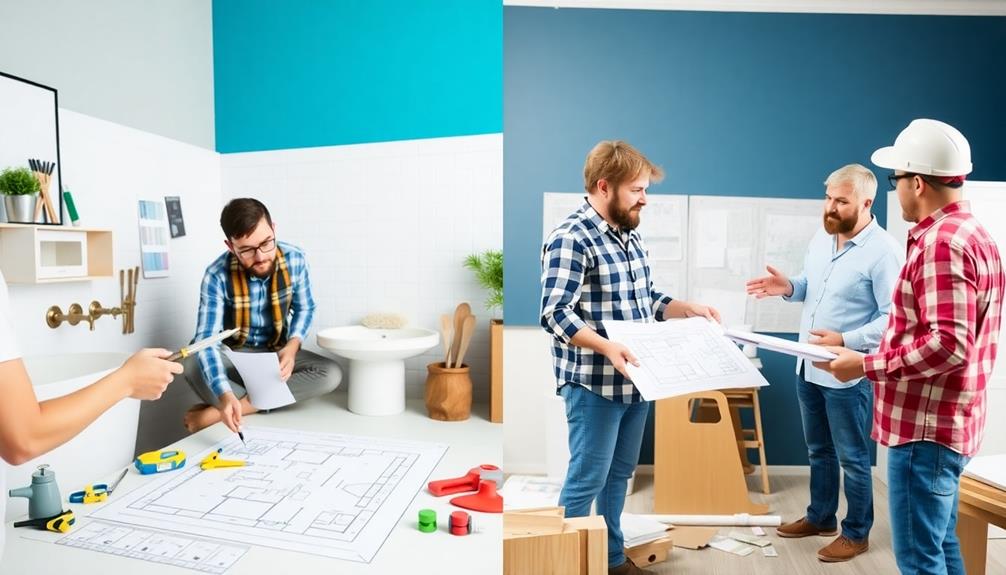
Before you start your bathroom remodel, take a moment to assess your skill level and the complexity of the tasks ahead.
Understanding the potential challenges, such as plumbing or electrical work, can help you determine whether to tackle the project yourself or hire a professional.
If you're comfortable with simple projects but unsure about plumbing or electrical work, it might be wise to hire a contractor.
Balancing your budget with your capabilities will help you make the best decision for your renovation.
Consider consulting resources on cold medications overview for insights that could inform your approach to managing any potential discomfort during your remodel.
Assess Your Skill Level
Evaluating your skill level is essential to deciding whether to tackle your bathroom remodel as a DIY project or hire a contractor. Start by honestly reviewing your past DIY experiences. If you've successfully completed smaller projects, you might feel confident.
However, complex tasks like plumbing or electrical work usually require professional expertise to guarantee safety and compliance with local codes. Additionally, consider if you have the tools and resources available, as some projects may necessitate specialized equipment. For example, a DIY fire pit can be a great project if you're comfortable with outdoor renovations.
Next, consider the specific requirements of your master bathroom remodel. Projects involving tile installation, fixture replacement, or structural changes often necessitate advanced skills. If you're unsure, hiring a licensed general contractor can provide peace of mind. They possess the necessary insurance and familiarity with local permits, which can help mitigate the risks of costly mistakes during renovation.
If you choose to DIY, focus on surface alterations like painting or installing new fixtures, which are generally manageable. Just remember to be cautious of hidden problems that may arise during the process.
Complexity of Tasks
Steering through the complexity of tasks in a bathroom remodel often involves weighing your DIY skills against the need for professional help. Simple tasks like painting or installing fixtures may be within your reach, but you should recognize when a project requires a licensed contractor.
Plumbing and electrical work, for instance, typically demand professional expertise to guarantee safety and compliance with local building codes, especially considering the potential risks associated with power consumption insights in such installations.
When deciding between DIY and hiring a contractor, consider the time commitment involved and the potential for mistakes. While DIY projects can add personal touches to your remodel, they can also lead to costly errors if not executed correctly.
Complex installations, like tiled showers or major layout changes, are best left to professionals who can maintain the structural integrity and value of your home.
Before making a decision, obtain multiple quotes from contractors to compare costs and services. Ascertain they've experience with bathroom remodels and can provide references.
Balancing DIY projects with professional installation will help you navigate the complexity of tasks effectively, making your bathroom remodel a successful and enjoyable endeavor.
Budget Considerations
Budgeting for a bathroom remodel requires careful consideration of whether you'll tackle the project yourself or hire professionals. Your budget will typically range from $15,000 to over $30,000, depending on your choices and the project's complexity.
If you decide to DIY, you can save on labor costs, but keep in mind that tasks like plumbing and electrical work often need a contractor's expertise for safety and compliance.
Conducting a cost-benefit analysis is essential in this decision-making process. While hiring professionals may lead to higher upfront costs, their experience can provide better quality and long-term satisfaction. It's worth weighing these factors against your own skills and the potential savings.
Additionally, don't forget to factor in unexpected costs. Renovations can quickly exceed initial estimates due to unforeseen issues such as structural repairs or material shortages.
To manage your budget effectively, consider exploring financing options, like home equity loans or grants, especially if you're leaning toward hiring contractors for more extensive work.
Ultimately, a well-structured budget will help you navigate your remodel with confidence.
Securing Permits and Codes
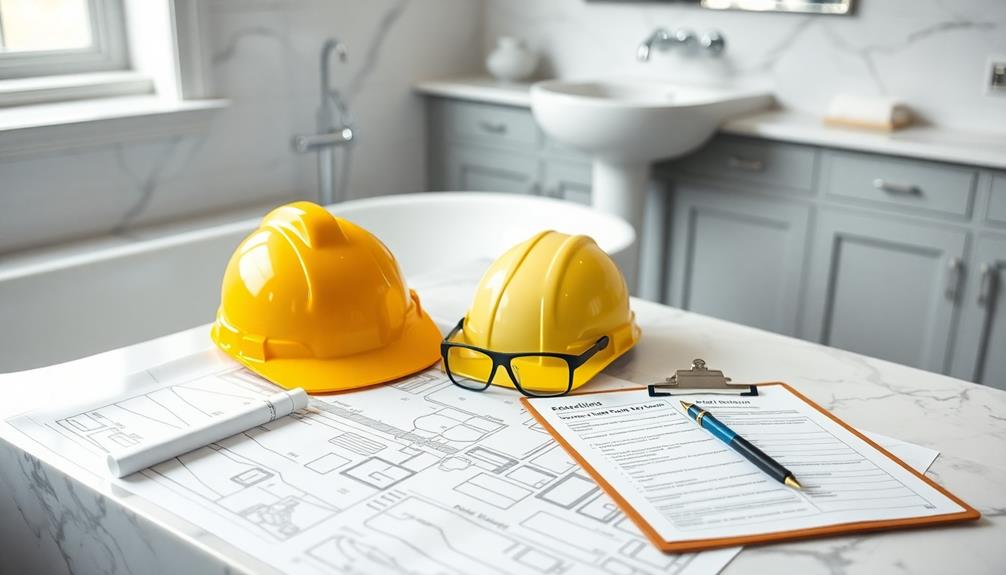
Before diving into your bathroom remodel, it's essential to check if you need permits, as many projects—especially those involving plumbing or electrical work—require them. Start by reviewing your local building codes to determine the specific requirements for your remodel. Most municipalities will ask for a site plan and detailed documentation, including before and after plans.
Here's a quick overview of what you might need:
| Permit Type | Common Requirements | Approval Time |
|---|---|---|
| Plumbing Permit | Detailed plumbing plans | Minutes to weeks |
| Electrical Permit | Electrical layout and safety plans | Minutes to weeks |
| General Building Permit | Site plan, project description | Days to weeks |
| Renovation Permit | Before and after plans, compliance docs | Minutes to weeks |
It's essential to include accurate contact information and a clear project description in your permit application to expedite the approval process. Failing to secure the necessary permits can lead to costly fines and complications when selling your home, so make sure you adhere to all legal requirements during your remodel.
Executing the Remodel
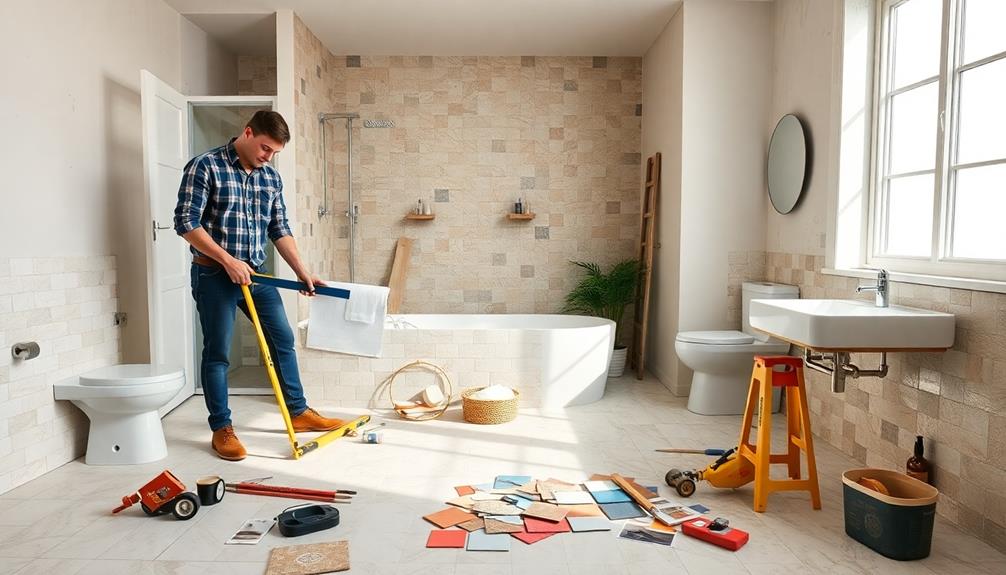
To execute your bathroom remodel effectively, start by creating a detailed project timeline that outlines each phase, from demolition to final inspections.
You'll also want to coordinate closely with your contractors to guarantee material delivery aligns with your schedule.
Clear communication is key, so keep everyone in the loop to tackle any unexpected issues as they arise.
Project Timeline Establishment
Establishing a clear project timeline is essential for executing your bathroom remodel smoothly. To achieve this, break down the remodel into distinct phases, ensuring you stay organized and focused.
Here's a suggested timeline to help you plan:
- Demolition (1-2 weeks): Start by tearing down the current layout. This phase allows for inspections and approvals before moving forward.
- Plumbing and Electrical Work (4-6 weeks): Plan for this important phase, as it involves installing major fixtures. Coordination may be necessary, so be prepared.
- Installation (2-3 weeks): Focus on cabinets, countertops, and other significant components during this time, ensuring they're in line with your design vision.
- Finishing Touches (2-3 weeks): Allocate time for painting, trim work, and decor to complete your space. This step is essential for making it functional and visually appealing.
As your project progresses, regularly update your timeline to adapt to any changes or delays.
Keeping communication open with everyone involved will help avoid unexpected costs and time extensions, ensuring a successful remodel.
Coordination With Contractors
Successfully coordinating with contractors during your bathroom remodel is vital for turning your vision into reality. Start by verifying all your contractors are properly licensed and insured to avoid any legal issues.
Schedule a pre-construction meeting to discuss the project timeline, set expectations, and address necessary permits. This initial meeting will help streamline the execution process.
Maintain open lines of communication with your contractors throughout the remodel. Share your design plans and any changes that arise promptly, as this can prevent misunderstandings and keep the project on track.
It's also important to create a detailed project timeline that outlines each phase of the remodel. Make sure contractors understand the sequence of tasks to avoid delays.
Regularly inspect the work being done to confirm it aligns with your vision and meets building codes. If you notice any issues, address them with your contractors immediately to prevent costly rework.
By staying engaged and proactive, you'll foster a cooperative environment that supports your goals and leads to a successful bathroom remodel.
Installation Essentials
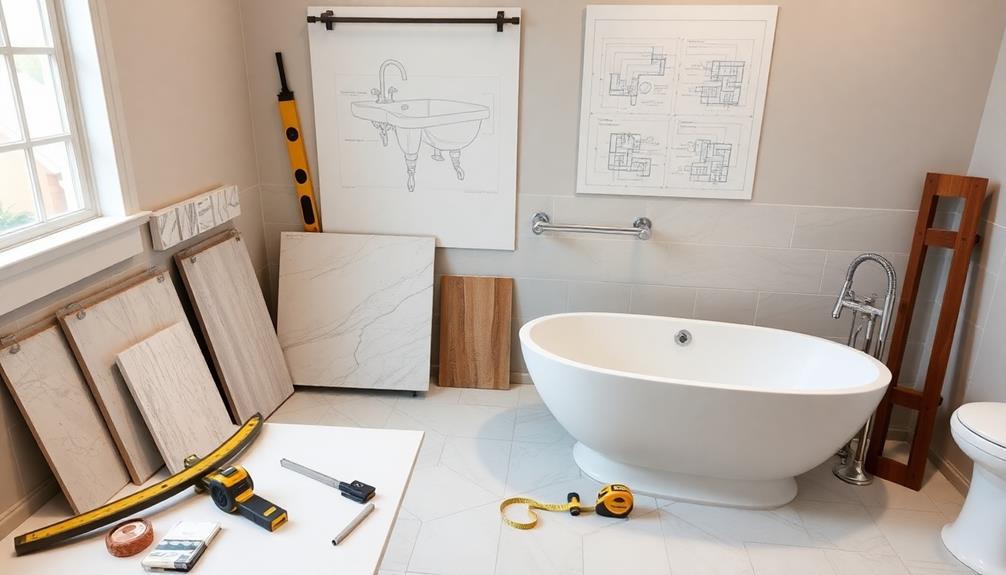
Installation essentials play an important role in ensuring your bathroom remodel is both functional and visually appealing. To achieve a successful installation, keep these key factors in mind:
- Flooring: Choose moisture-resistant materials like ceramic tile, porcelain tile, or luxury vinyl. These options offer durability and slip resistance, significant for a bathroom.
- Toilet Installation: Install the toilet after laying the flooring. Use a wax ring for a watertight seal, and make sure the toilet is level to prevent leaks.
- Ventilation: Adequate ventilation is essential. Install a high-quality exhaust fan to reduce humidity and prevent mold growth, keeping your bathroom fresh and safe.
- Countertops: Select premium materials like quartz or natural stone for your countertops. Proper installation is important for functionality and to enhance the overall aesthetic of your master bathroom.
Final Touches and Maintenance

Once you've completed the installation essentials, it's time to focus on the final touches that can truly elevate your bathroom's look and functionality.
Start by adding moulding and window treatments that not only enhance the aesthetic but also improve privacy and light control. Select moisture-resistant rugs and mats to guarantee durability in your humid environment; this helps prevent mold growth and keeps your space clean.
Next, incorporate personal touches in your decor, like artwork or plants, to create a unique and inviting atmosphere that reflects your style.
Evaluate the overall functionality of the space, confirming that all fixtures and design elements align with your initial vision and meet your daily needs.
Regular maintenance is key to preserving your bathroom's beauty and functionality. Establish a routine that includes washing bath mats and guaranteeing proper ventilation.
These small steps can considerably extend the life of your fixtures and materials. By focusing on these final touches and committing to maintenance, you'll enjoy a master bathroom that's not only visually appealing but also practical for everyday use.
Frequently Asked Questions
How Much Should You Spend on a Master Bathroom Remodel?
You should spend about 5-10% of your home's value on a master bathroom remodel. Typically, mid-range projects average around $18,000, but high-end renovations can exceed $30,000, so budget wisely for unexpected costs.
What Is the Correct Order to Remodel a Bathroom?
To remodel a bathroom, start with demolition, then tackle plumbing and electrical work. Schedule inspections, followed by drywall and flooring installation. Finally, install fixtures and cabinetry, adding finishing touches for a polished look.
Where Do I Start When Planning a Bathroom Renovation?
Imagine stepping into a serene oasis. Start your bathroom renovation by evaluating your current layout, identifying pain points, and sketching your dream design. Consulting a contractor will help refine your vision and feasibility.
What Is the Most Expensive Part of a Bathroom Remodel?
The most expensive part of a bathroom remodel is typically labor costs. Skilled trades like plumbing and electrical work can consume 20% to 35% of your budget, greatly impacting your overall renovation expenses.
Conclusion
Now that you've mapped out your master bathroom remodel, remember: it's not just about the space, but how it makes you feel. With thoughtful planning and attention to detail, your dream oasis is within reach. Don't rush the process—take your time to choose what truly resonates with you. After all, a well-designed bathroom can transform the mundane into a daily retreat. So, roll up your sleeves and get ready to create a sanctuary that reflects your style!
